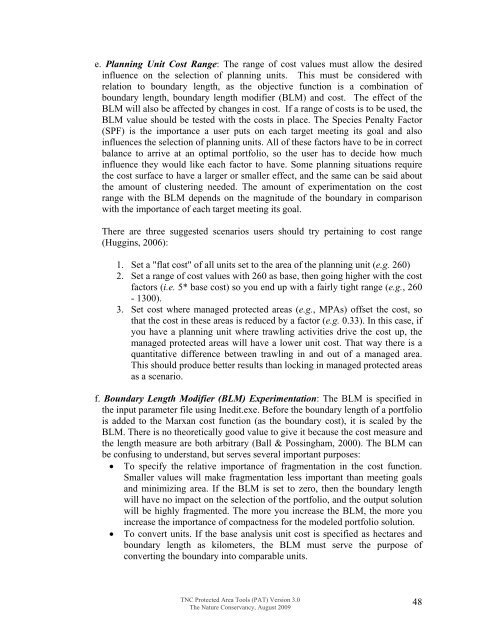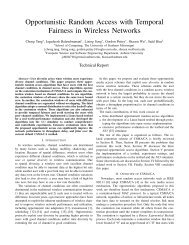Download the Tutorial
Download the Tutorial
Download the Tutorial
Create successful ePaper yourself
Turn your PDF publications into a flip-book with our unique Google optimized e-Paper software.
e. Planning Unit Cost Range: The range of cost values must allow <strong>the</strong> desiredinfluence on <strong>the</strong> selection of planning units. This must be considered withrelation to boundary length, as <strong>the</strong> objective function is a combination ofboundary length, boundary length modifier (BLM) and cost. The effect of <strong>the</strong>BLM will also be affected by changes in cost. If a range of costs is to be used, <strong>the</strong>BLM value should be tested with <strong>the</strong> costs in place. The Species Penalty Factor(SPF) is <strong>the</strong> importance a user puts on each target meeting its goal and alsoinfluences <strong>the</strong> selection of planning units. All of <strong>the</strong>se factors have to be in correctbalance to arrive at an optimal portfolio, so <strong>the</strong> user has to decide how muchinfluence <strong>the</strong>y would like each factor to have. Some planning situations require<strong>the</strong> cost surface to have a larger or smaller effect, and <strong>the</strong> same can be said about<strong>the</strong> amount of clustering needed. The amount of experimentation on <strong>the</strong> costrange with <strong>the</strong> BLM depends on <strong>the</strong> magnitude of <strong>the</strong> boundary in comparisonwith <strong>the</strong> importance of each target meeting its goal.There are three suggested scenarios users should(Huggins, 2006):try pertaining to cost range1. Set a "flat cost" of all units set to <strong>the</strong> area of <strong>the</strong> planning unit (e.g. 260)2. Set a range of cost values with 260 as base, <strong>the</strong>n going higher with <strong>the</strong> costfactors (i.e. 5* base cost) so you end up with a fairly tight range (e.g., 260- 1300).3. Set cost where managed protected areas (e.g., MPAs) offset <strong>the</strong> cost, sothat <strong>the</strong> cost in <strong>the</strong>se areas is reduced by a factor (e.g. 0.33). In this case, ifyou have a planning unit where trawling activities drive <strong>the</strong> cost up, <strong>the</strong>managed protected areas will have a lower unit cost. That way <strong>the</strong>re is aquantitative difference between trawling in and out of a managed area.This should produce better results than locking in managed protected areasas a scenario.f. Boun dary Length Modifier (BLM) Experimentation: The BLM is specified in<strong>the</strong> input parameter file using Inedit.exe. Before <strong>the</strong> boundary length of a portfoliois added to <strong>the</strong> Marxan cost function (as <strong>the</strong> boundary cost), it is scaled by <strong>the</strong>BLM. There is no <strong>the</strong>oretically good value to give it because <strong>the</strong> cost measure and<strong>the</strong> length measure are both arbitrary (Ball & Possingham, 2000). The BLM canbe confusing to understand, but serves several important purposes:• To specify <strong>the</strong> relative importance of fragmentation in <strong>the</strong> cost function.Smaller values will make fragmentation less important than meeting goalsand minimizing area. If <strong>the</strong> BLM is set to zero, <strong>the</strong>n <strong>the</strong> boundary lengthwill have no impact on <strong>the</strong> selection of <strong>the</strong> portfolio, and <strong>the</strong> output solutionwill be highly fragmented. The more you increase <strong>the</strong> BLM, <strong>the</strong> more youincrease <strong>the</strong> importance of compactness for <strong>the</strong> modeled portfolio solution.• To convert units. If <strong>the</strong> base analysis unit cost is specified as hectares andboundary length as kilometers, <strong>the</strong> BLM must serve <strong>the</strong> purpose ofconverting <strong>the</strong> boundary into comparable units.TNC Protected Area Tools (PAT) Version 3.0The Nature Conservancy, August 200948
















